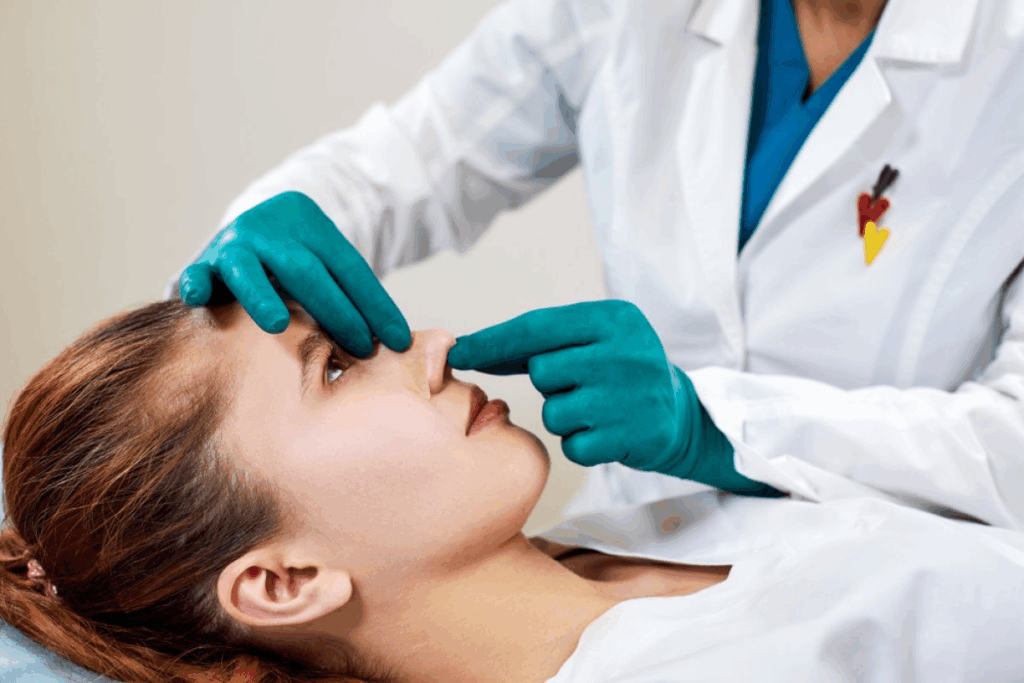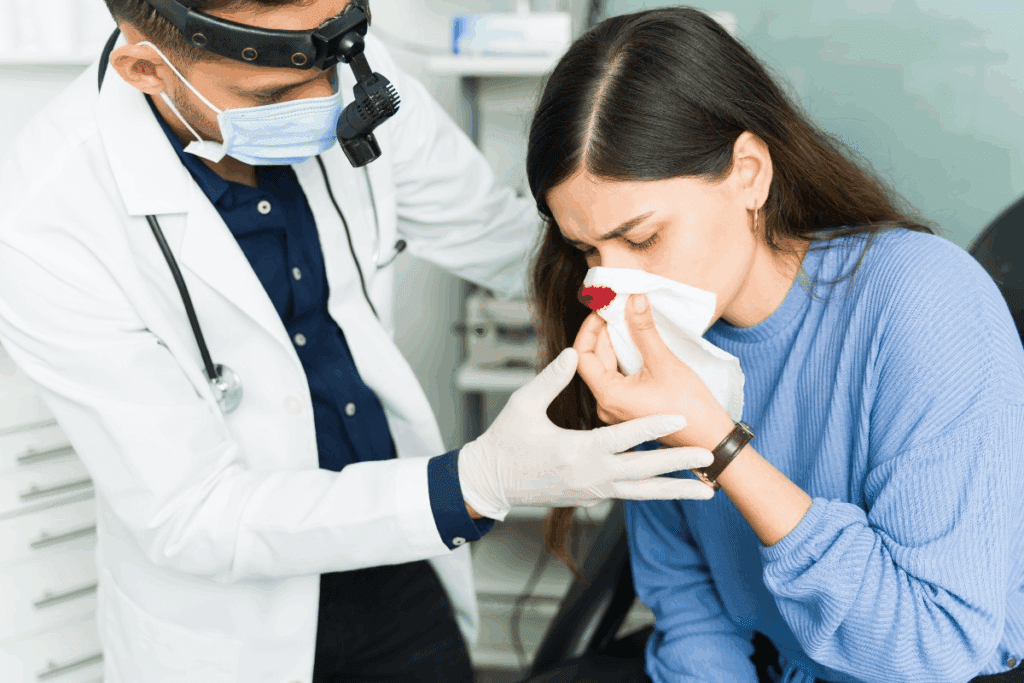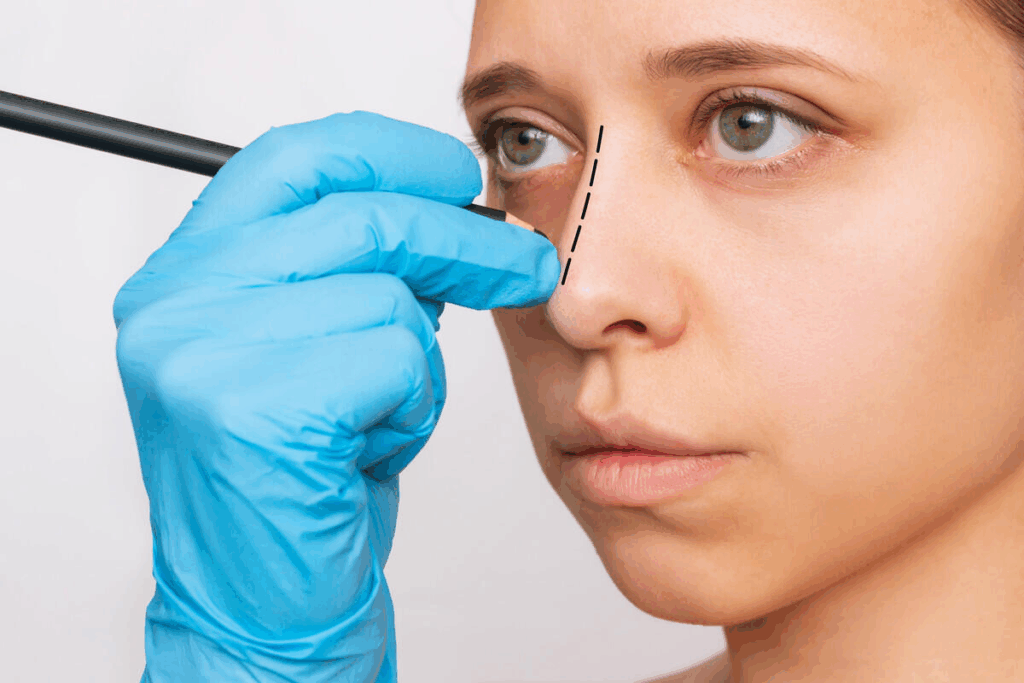Last Updated on October 31, 2025 by Saadet Demir

Deviated septum treatment options, including medical relief for symptoms and surgical correction for structural issues. Getting ready for deviated nasal septum surgery, also known as septoplasty, is very important. Studies show that patients see big improvements in breathing and life quality after the surgery.
Your doctor will check your medical history before the nasal septum operation. They will look at any medicines or supplements you take. This is to make sure the surgery goes smoothly and safely.
Knowing what to expect and preparing well can help you get the most out of septoplasty. We’ll show you how to get ready for this surgery that can really improve your life.

Knowing the causes and symptoms of a deviated nasal septum is key to finding the right treatment. A deviated nasal septum happens when the thin wall between the nasal passages shifts. This makes one passage smaller than the other.
This issue can cause breathing problems, like nasal congestion and trouble breathing. It also raises the chance of getting nasal infections. While small septum issues might not need treatment, a severe one might require surgery, called septoplasty.
Many things can cause a deviated septum, like genetics, injury, or abnormal growth. It can also happen due to wear and tear over time, causing the septum to shift.
Common causes include:
The symptoms of a deviated septum can range from mild to severe. Some people might just have a bit of nasal congestion. Others might have trouble breathing that affects their sleep and overall health.
A study of 721 patients showed that septoplasty can help with nasal obstruction symptoms. It found that those with severe septum deviation saw big improvements in their quality of life after surgery.
Symptom | Description | Impact on Quality of Life |
Nasal Congestion | Difficulty breathing through the nose | Reduced sleep quality, daytime fatigue |
Nasal Discharge | Excessive mucus production | Frequent nose blowing, discomfort |
Loss of Smell | Reduced ability to smell odors | Impact on appetite, enjoyment of food |
In conclusion, knowing the causes and symptoms of a deviated nasal septum is vital. Recognizing the signs and talking to a healthcare professional can help find the right treatment. This can improve one’s quality of life.

Learning about deviated nasal septum surgery is key for those thinking about septoplasty. This surgery fixes the nasal septum’s displacement. It’s a top choice for those with nasal blockage and other symptoms.
Septoplasty is usually done as an outpatient procedure. It can take 30 to 90 minutes. The surgery uses anesthesia to keep the patient comfortable.
The surgeon makes an incision on one side of the nasal septum. They remove the parts that block the airway. Then, they put the septum back in its right place. New tools and techniques have made septoplasty more successful.
Recent studies show septoplasty greatly improves patients’ lives. At 6 months after surgery, patients scored 25 points higher on quality-of-life measures. This is because the surgery fixes the nasal septum, improving airflow and reducing blockage.
Outcome Measure | Pre-Operation | 6 Months Post-Operation |
Nasal Obstruction Symptoms | Severe | Mild |
Quality of Life | Poor | Improved |
Airflow | Restricted | Improved |
These results highlight septoplasty’s success in treating deviated nasal septum issues. Knowing the science behind the surgery helps patients choose the best treatment.
Knowing when to choose surgery for a deviated septum is key. The choice to have deviated septum surgery depends on symptoms, treatment success, and life quality. It’s a big decision.
If treatments like meds, nasal strips, or lifestyle changes don’t work, it’s time to think about nasal septum surgery. We suggest trying non-surgical options first. But if problems keep coming back, surgery might be needed.
Conservative Treatment | When to Consider Surgery |
Nasal decongestants | Symptoms persist or worsen |
Nasal strips | No improvement in breathing |
Lifestyle changes | Continued sleep disturbances |
A deviated septum can really mess with your daily life and sleep. If you’re always congested, can’t breathe, or can’t sleep well, see a septoplasty surgeon. Good sleep and breathing are vital for health.
Some health issues and symptoms mean you need deviated septum surgery. These include frequent sinus infections, big nasal blockages, and trouble breathing through your nose. We help figure out the best treatment for you.
If you have a fever or trouble breathing before surgery, call your doctor. We’re here to help with all your needs during surgery.
Choosing the right surgeon for deviated nasal septum surgery is very important. It affects how well the surgery goes. When looking for deviated septum surgery in NYC or septoplasty in New York, find a skilled and experienced surgeon.
When searching for a septorhinoplasty surgeon, look for certain qualifications. Your surgeon should be board-certified in otolaryngology (ENT) or plastic surgery. This shows they have the right training and skills for the surgery.
Also, check if they have experience with deviated septum corrections. A good surgeon will have a track record of successful surgeries.
It’s also good to see if they have specialized training in nasal or sinus surgery. Being part of professional societies, like the American Academy of Otolaryngology, shows they keep up with new techniques.
During your first meeting, ask important questions. This helps you understand if the surgeon is right for you. Some key questions include:
Pay attention to how well the surgeon answers your questions. Also, see how comfortable you feel with their responses.
Looking at before and after photos is a great way to judge a surgeon’s skill. It shows you what results you might get. Look for consistency in the results and cases similar to yours.
Ask to see different cases to get a full picture of the surgeon’s abilities. Also, reading patient testimonials can tell you about the surgeon’s care and bedside manner.
By carefully looking at these factors, you can choose the best septorhinoplasty surgeon for your surgery. This ensures the best results for your procedure.
Knowing what happens in the first meeting can ease worries for those thinking about nasal septum surgery. This important step has several parts. They help your doctor figure out the best treatment for you.
Your doctor will start by looking over your medical history. You’ll talk about your symptoms, past health issues, and any medicines you’re taking. This is key to understanding your health and how it might affect your surgery and healing.
A physical check-up is a big part of the first meeting. Your doctor will look at your nasal passages. They’ll see how big the deviation is and check for other issues. This helps them plan your surgery.
At times, your doctor might ask for imaging or tests to look at your nasal septum and sinuses. These could be CT scans or nasal endoscopy. The results help plan your surgery and aim for the best results.
The table below shows what happens in the initial consultation:
Component | Description | Purpose |
Medical History Review | Discussion of symptoms, medical conditions, and medications | Understand overall health and how it might affect surgery and recovery |
Physical Examination | Examination of nasal passages to assess deviation and other abnormalities | Plan the surgical approach |
Imaging Studies and Diagnostic Tests | CT scans or nasal endoscopy to evaluate the nasal septum and sinuses | Provide detailed information for surgical planning |
Understanding the initial consultation can help patients get ready for nasal septum surgery. Being prepared can make the process less stressful and smoother.
Getting ready financially for deviated nasal septum surgery is key. Knowing the costs and how to handle them can ease stress. It lets patients focus on getting better.
First, check your insurance for septoplasty coverage. Most plans cover it if it’s needed. But, coverage can differ a lot based on your plan and provider.
It’s smart to look over your policy and talk to your insurance. Ask about what’s covered and what’s not. Some questions to ask include:
Even with insurance, you might face extra costs. These can be deductibles, copays, and costs for services not covered. Plan for these to avoid surprises.
Common extra costs include:
Expense Category | Average Cost |
Deductibles | $500 – $1,000 |
Copays | $20 – $50 per visit |
Additional Tests | $100 – $500 |
If surgery costs worry you, there are payment plans. Many providers offer financing or payment plans. This way, you can pay over time, not all at once.
Talking to your healthcare provider about payment plans can help find the best option. Some providers might offer discounts for early payment or package deals.
Understanding the financial side of septum surgery is vital. Knowing your insurance, planning for extra costs, and looking at payment plans can help manage finances. This way, patients can focus on recovery without worry.
In the weeks before your deviated nasal septum surgery, you’ll need to do some medical prep. This is to make sure you’re healthy and ready for the surgery. Your healthcare team will help you with these steps.
Some medicines can make bleeding more likely during and after surgery. You should stop taking aspirin, ibuprofen, and other NSAIDs as your doctor tells you. It’s also important to tell your doctor about all the medicines you’re taking, including vitamins and supplements.
Medication Type | Action Required | Reason |
Aspirin and NSAIDs | Stop taking as directed by your doctor | Increased risk of bleeding |
Vitamin Supplements | Inform your doctor | Potential interaction with anesthesia |
Prescription Medications | Discuss with your healthcare provider | Adjustments may be necessary |
You’ll need to do some tests before your septoplasty. These tests check if you’re healthy enough for surgery. You might have blood work, a physical exam, and maybe even a CT scan. Your doctor will tell you what tests you need and when.
Changing your lifestyle can help your surgery go well. Here are some things we suggest:
These changes can make you healthier and help your body heal better after surgery.
Eating well is important for your recovery. We suggest:
By following these diet tips, you’ll be in the best shape for your surgery.
To make your recovery after deviated septum surgery comfortable, prepare your home first. A well-organized space helps you rest and heal better.
Having a dedicated recovery area is key. It should be quiet, comfy, and easy to get to. Think about setting up a cozy spot with:
Having everything you need close by means less getting up. This helps reduce discomfort and promotes rest.
Before your septoplasty recovery starts, get these supplies ready:
Having someone to help you early on is very helpful. Think about asking a family member or friend to:
This support is invaluable for your safety and comfort early on.
Planning meals ahead can reduce stress and keep you nourished. Consider:
By doing these things, you can create a supportive environment for a smooth nasal septum operation recovery.
One day before your surgery, follow a specific routine for a smooth process. Preparing for your deviated nasal septum surgery means paying attention to important details. These details ensure your safety and comfort during the procedure.
Don’t eat or drink, including alcohol, for at least six hours before your septoplasty surgery. This is for your safety while you’re under anesthesia. Have a light meal the night before and drink water until the fasting period starts.
Good hygiene is key before your surgery. Shower or bathe the night before or early in the morning. Don’t use lotions, creams, or makeup that could mess with the surgical area.
To make check-in smooth on surgery day, gather these items:
Having these ready will help reduce stress on surgery day.
Mental prep is as important as physical prep. Try deep breathing, meditation, or calming music to lower anxiety. Having a friend or family member with you can also help.
Your septoplasty journey continues on the day of surgery. A well-coordinated process ensures a smooth experience. We know this day can be exciting and nerve-wracking. So, we’re here to guide you through every step.
On the day of your deviated nasal septum surgery, arrive at the hospital or surgical center early. You’ll need to arrive a few hours before your surgery to check in. During check-in, you’ll provide identification, insurance information, and confirm your medical history.
Our staff will make sure all paperwork is done quickly. This lets you focus on preparing for your procedure.
After settling in, an anesthesiologist will talk to you about the anesthesia process. They’ll explain the type of anesthesia and answer any questions. For septoplasty, the anesthesia used can be local with sedation or general anesthesia.
The septoplasty procedure usually takes one to three hours. Your surgical team will use the latest techniques to fix your deviated nasal septum. They’ll make incisions inside the nose to remove or reposition the cartilage and bone.
The goal is to improve airflow and breathing. They aim to do this while keeping your nose’s structure intact.
After surgery, you’ll go to a recovery area. Our medical team will watch over you closely. You might feel some discomfort, nasal congestion, or mild swelling, but these symptoms are temporary.
Our staff will give you detailed instructions on post-operative care. They’ll tell you how to manage any discomfort and what to expect during your recovery.
The recovery after deviated nasal septum surgery is key. It needs careful planning and following post-operative instructions. Knowing the timeline and care guidelines is important for a smooth recovery.
The first 48 hours are critical for a good recovery. Make sure someone drives you home and helps you at home for the first day. Resting is important to avoid discomfort and complications.
In the first week, you might feel nasal congestion, swelling, and mild discomfort. Following these guidelines can help:
In weeks 2-4, you can slowly increase your activity. But, it’s important to avoid certain activities to prevent problems.
Knowing when to contact your doctor is important. If you have severe pain, heavy bleeding, or trouble breathing, get medical help right away. Also, report any signs of infection, like fever or increased redness, to your healthcare provider.
“Proper post-operative care is key to avoiding complications and getting the best results from deviated nasal septum surgery.”
— Expert Opinion
By following these guidelines and staying in touch with your healthcare provider, you can smoothly go through the recovery. This will help you get the best results from your septoplasty.
Following the guidelines in this article helps patients have a smooth recovery from deviated nasal septum surgery, also known as septoplasty.
Preparation is key for a successful nasal septum operation. We’ve outlined steps before, during, and after surgery. This helps avoid complications and promotes healing.
Most people can go back to work within a week after septoplasty. Knowing what to expect and taking precautions makes the recovery process easier.
We stress the importance of thorough preparation and post-operative care. This ensures the best outcome from deviated nasal septum surgery.
A deviated nasal septum happens when the thin wall between the nasal passages shifts. This makes one passage smaller than the other.
Common signs include nasal congestion and trouble breathing. You might also lose your sense of smell, get nosebleeds, or have sinus infections. Some people feel facial pain or headaches.
A doctor will examine you, look at your medical history, and might use a nasal endoscopy or CT scan. This helps figure out if you have a deviated septum.
Septoplasty is a surgery to fix a deviated nasal septum. It involves adjusting or removing parts of the septum. This helps improve breathing and sinus drainage.
The surgery usually lasts between 30 minutes to an hour and a half. This depends on how complex the case is.
Septoplasty is done under general anesthesia or local anesthesia with sedation. This makes sure you’re comfortable during the surgery.
Risks include bleeding, infection, and reactions to anesthesia. Specific to septoplasty, you might face septal perforation, nasal dryness, or changes in your nose’s shape.
The first few days to a week are usually the hardest part of recovery. Most people can get back to normal activities in 1-2 weeks. But, it can take several weeks to fully recover.
You might feel nasal congestion, swelling, and possibly some bruising around your eyes. Doctors might use nasal packing or splints to help the septum heal.
Many insurance plans cover septoplasty if it’s medically necessary. But, coverage can vary. It’s best to check with your insurance provider.
Look for a board-certified otolaryngologist (ENT specialist) with septoplasty experience. Check their credentials, read reviews, and ask for before-and-after photos.
Follow your surgeon’s instructions. This might include stopping certain medications, avoiding smoking, and arranging for post-operative care.
Yes, septoplasty can be done with other procedures. This can help address related issues like turbinate reduction or sinus surgery.
Septoplasty is mainly a functional surgery. But, it can sometimes cause minor changes to your nose’s appearance. Talk to your surgeon about your concerns.
Subscribe to our e-newsletter to stay informed about the latest innovations in the world of health and exclusive offers!
WhatsApp us